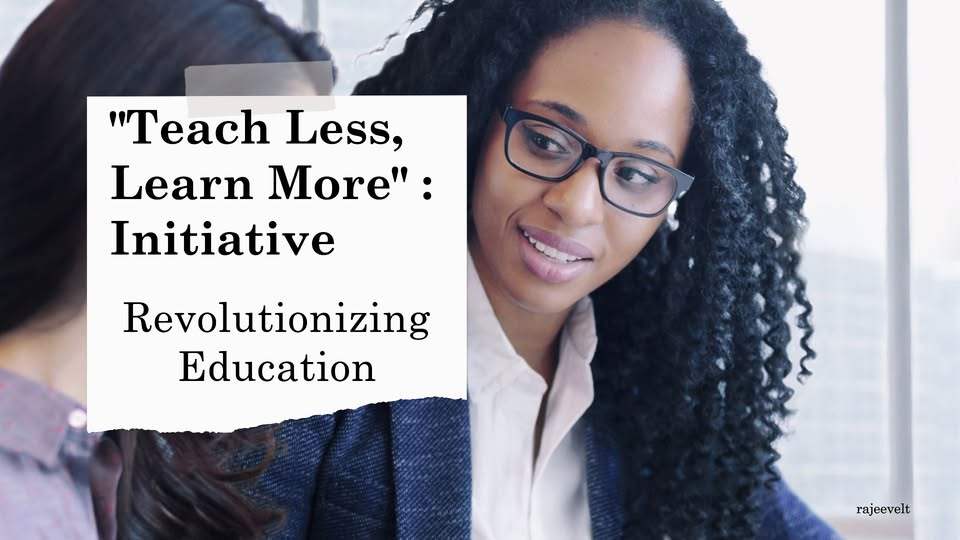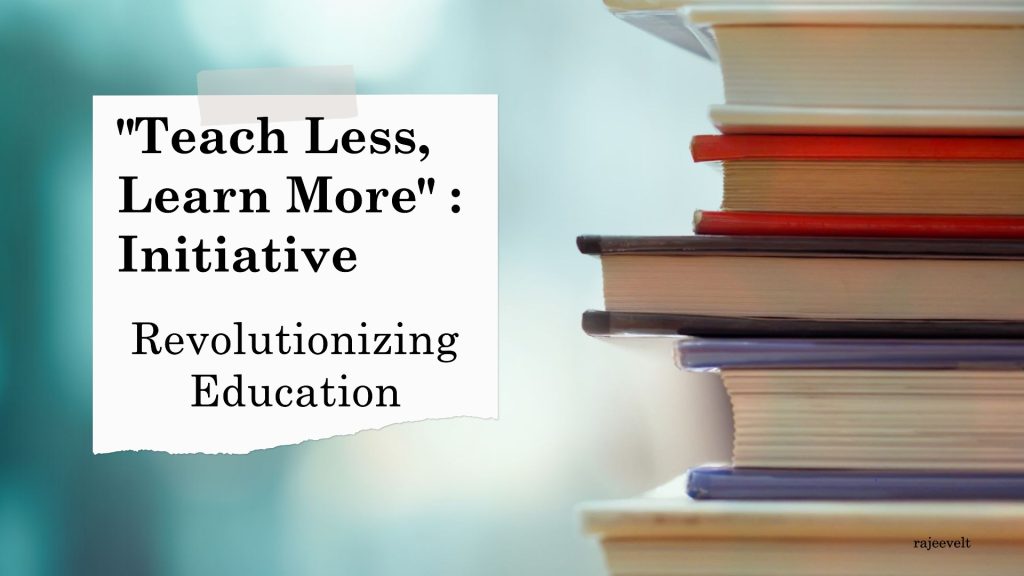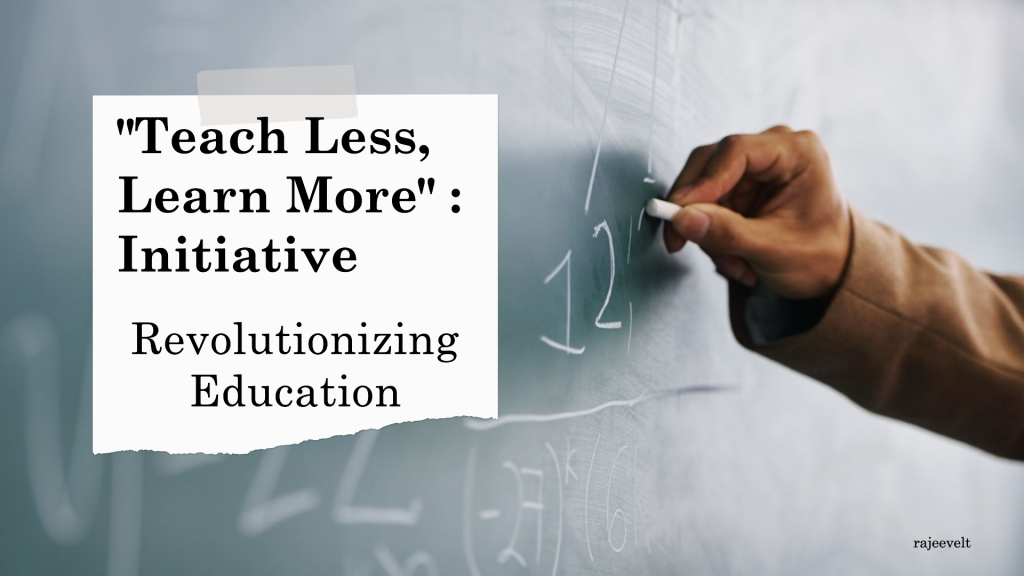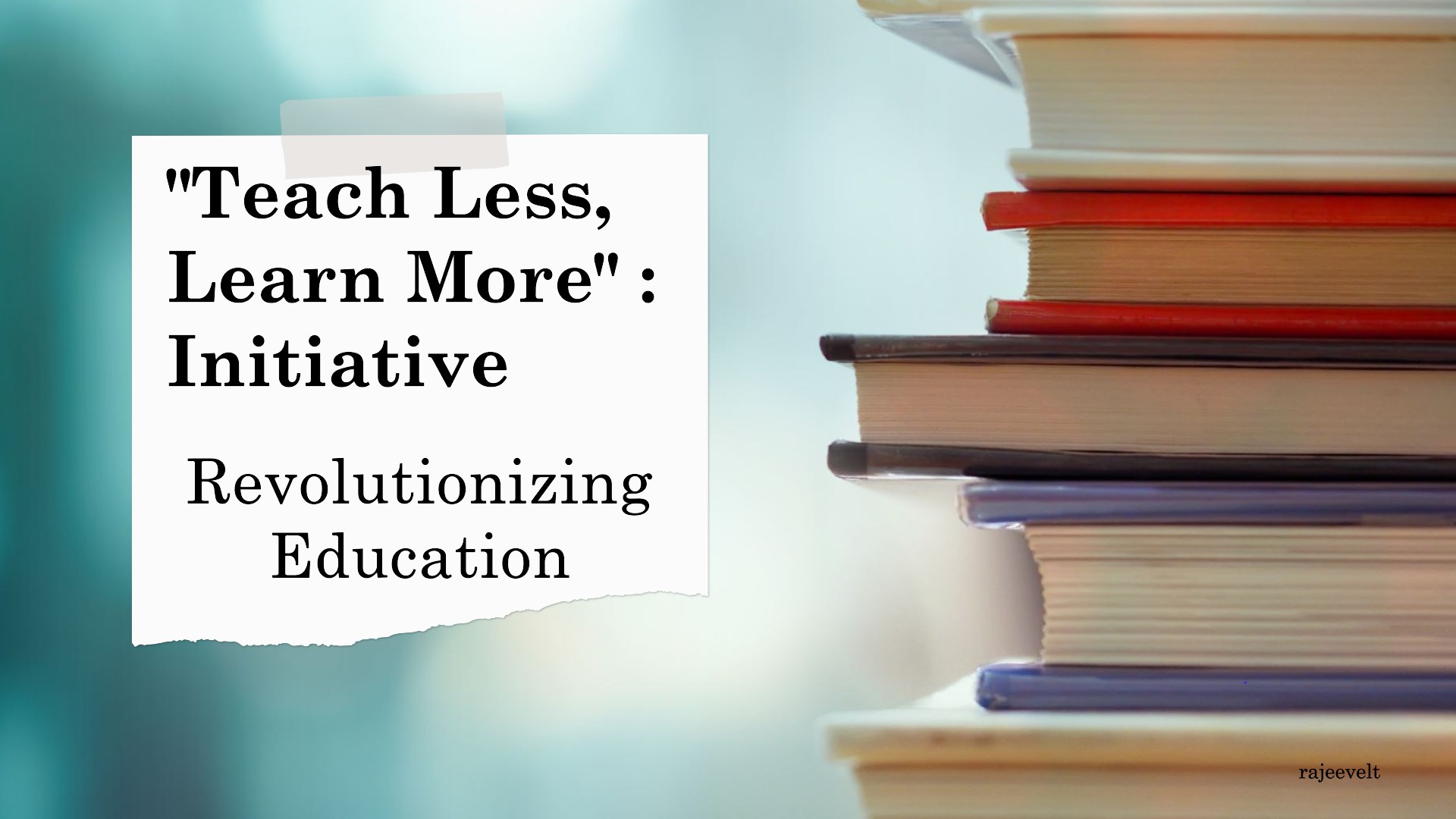
Actionable Strategies for Implementing “Teach Less, Learn More” in K–12 Schools
Introduction
The philosophy of “Teach Less, Learn More” (TLLM) emerged as a response to the growing recognition that the traditional model of education—centered on content-heavy curricula, rote memorization, and standardized assessments—was no longer sufficient to prepare students for the complexities of the twenty-first century. Initiated formally in, The TLLM initiative (Singapore, 2005) sought to reframe education by emphasizing quality over quantity, prioritizing deeper understanding over superficial coverage, and cultivating skills such as critical thinking, creativity, and lifelong learning (Ministry of Education Singapore, 2005; Ng, 2008). The underlying assumption of TLLM is not that teachers should literally reduce instructional time, but rather that educators should focus more deliberately on what truly matters in learning. Therefore, schools can create the conditions for learners to engage meaningfully with knowledge, apply it in authentic contexts, and develop dispositions that extend beyond the classroom.
The TLLM philosophy resonates with broader educational reforms. Finland’s education system exemplifies a similar ethos by reducing standardized testing and entrusting teachers with autonomy to design learning that prioritizes student well-being and agency (Sahlberg, 2011; Sahlberg, 2021). Likewise, global frameworks such as UNESCO’s Rethinking Education report (2015) advocate moving beyond content transmission to focus on competencies essential for democratic citizenship, sustainability, and innovation. The urgency of this shift is magnified in today’s “VUCA” world—volatile, uncertain, complex, and ambiguous—where adaptability, creativity, and resilience matter more than memorizing static facts (Fullan & Langworthy, 2014).
1. Redesigning the Curriculum Around Core Concepts
The foundation of TLLM lies in a curriculum that emphasizes conceptual depth rather than breadth. Traditional education often overwhelms learners with fragmented content, leaving little time for reflection, inquiry, or application. Schools should conduct curriculum audits to identify redundancies, streamline topics, and prioritize essential disciplinary “big ideas.” In mathematics, for instance, rather than rushing through numerous formulas and procedures, curricula can emphasize underlying principles such as proportionality, functions, and mathematical reasoning. This not only reduces cognitive overload but also helps learners transfer knowledge across contexts (Ng, 2008).
Singapore’s own curriculum reform under TLLM exemplifies this strategy. The Ministry of Education sought to “teach less” by slimming syllabi in subjects such as science and humanities, thereby creating space for “learning more” through inquiry and project work. The students were encouraged to understand processes of investigation and experiment design instead of memorizing scientific facts (Tan, 2013). A similar movement occurred in the United States under the Next Generation Science Standards (NGSS), which emphasize crosscutting concepts and practices rather than exhaustive factual coverage (National Research Council, 2012).
The advantage of focusing on core concepts is twofold. First, it allows teachers and students to linger on complex, meaningful issues, cultivating higher-order thinking and curiosity. Second, it builds durable knowledge structures that serve as anchors for lifelong learning. However, curriculum redesign also faces challenges. Teachers may feel pressure from parents or policymakers who equate breadth with rigor. It requires strong communication and leadership, as well as alignment between curriculum, assessment, and pedagogy. The schools ensure that learners not only acquire knowledge by deliberately curating what matters most, but also understand how and why it matters.
2. Integrating Inquiry- and Project-Based Learning
Inquiry- and project-based learning (PBL) operationalize the “learn more” dimension of TLLM by placing students at the center of the learning process. The learners engage in authentic, open-ended tasks that require critical thinking, collaboration, and creativity rather than passively receiving information i.e. instead of reading about ecosystems in a textbook, students might investigate local biodiversity through fieldwork, data collection, and presentations to their community. Such experiences deepen understanding while also developin communication and problem-solving skills (Zhao, 2012).
Singapore’s Project Work initiative under TLLM provides a concrete case study. High school students are required to complete interdisciplinary projects that demand research, teamwork, and oral communication. This reform not only diversifies assessment but also nurtures twenty-first-century skills such as collaboration and innovation (Ng, 2008). Similarly, Finland incorporates phenomenon-based learning, where students explore real-world issues—such as climate change or migration—through interdisciplinary projects, connecting learning across subjects (Sahlberg, 2021).
The pedagogical benefits of inquiry- and project-based learning are well established. Research shows that students engaged in PBL demonstrate improved retention of knowledge, greater intrinsic motivation, and stronger skills in critical thinking compared to peers in traditional classrooms (Darling-Hammond, 2017). However, successful implementation requires systemic support. Teachers should be trained to design open-ended inquiries, manage group dynamics, and assess complex outcomes. Schools must also allow time and resources for extended projects. Importantly, inquiry does not mean abandoning rigor—projects should be aligned with core learning goals and scaffolded to ensure equitable participation.
PBL embodies the ethos of TLLM by showing that teaching less content, when coupled with opportunities for active exploration, enables students to learn more deeply and sustainably.


3. Integrating Technology for Personalized Pathways
Technology offers powerful tools to make TLLM feasible in today’s diverse classrooms. Adaptive learning platforms, for instance, allow instruction to be personalized to individual students’ pace and needs, ensuring that learners are neither left behind nor unchallenged. Mathematics platforms can adjust problem sets based on real-time performance, while reading applications can recommend texts suited to individual comprehension levels. This personalization aligns with the TLLM philosophy by shifting the teacher’s role from direct instruction to facilitator and mentor (Fullan & Langworthy, 2014).
Blended learning models illustrate how technology can expand opportunities for deeper learning. Routine content delivery is offloaded to digital platforms—through videos, simulations, or online discussions—freeing classroom time for collaborative problem-solving, inquiry, and mentoring. Schools in the United States, such as those within the Summit Public Schools network, have successfully used personalized learning platforms to allow students to set goals, track progress, and engage in project-based work (Darling-Hammond, 2017). Similarly, during the COVID-19 pandemic, many Indian schools discovered how digital tools could extend learning beyond textbooks, sparking long-term changes in instructional design.
The integration of technology also facilitates global learning. Students can collaborate across borders, access diverse perspectives, and explore real-world problems with authentic data sources. This broadens horizons and prepares learners for global citizenship. Yet, technology is not a panacea. It risks reinforcing inequality without thoughtful integration, especially in contexts with limited access to devices and connectivity. Moreover, excessive screen time can undermine student well-being. Therefore, the role of educators remains central: teachers must curate digital tools purposefully, blending them with face-to-face interaction to create balanced, meaningful experiences.
Technology provides the infrastructure for personalized, flexible learning pathways that exemplify the spirit of TLLM.
4. Shifting Assessment Toward Competency and Performance
Assessment systems profoundly influence teaching and learning. The teachers often feel compelled to “teach to the test,” narrowing curricula and discouraging creativity under traditional regimes dominated by standardized testing. Assessment should be reimagined to value depth, competency, and performance for TLLM to succeed. This entails moving beyond one-time, high-stakes examinations to incorporate diverse, authentic measures of learning (Darling-Hammond, 2017).
Competency-based assessment provides one promising model. Here, progress is measured not by seat time or test scores but by demonstrations of mastery. Students advance upon showing proficiency in specific skills or concepts, allowing them to learn at their own pace. Tools such as digital portfolios, capstone projects, and exhibitions showcase learning in holistic ways. Assessment gradually expanded to include school-based performance tasks, reducing reliance on national exams in Singapore’s TLLM reforms. Similarly, Finland’s trust-based system emphasizes formative assessment, teacher-designed evaluations, and feedback over standardized tests (Sahlberg, 2011).
Performance assessments also integrated with real-world learning. A student might demonstrate language proficiency through a debate, or scientific understanding through designing and presenting an experiment. Such assessments capture not only knowledge but also communication, collaboration, and creativity. While these practices are more resource-intensive, they provide a richer and more equitable picture of student learning.
The challenge lies in balancing innovation with accountability. Parents and policymakers often demand comparability and standardization. Thus, hybrid systems may be needed, combining national benchmarks with school-based assessments. The key principle, however, remains clear: when assessments reward deeper thinking and authentic application, they reinforce the “learn more” dimension of TLLM.

5. Building Teacher Capacity and Collaborative Cultures
Teachers are the linchpins of TLLM. Without their buy-in, expertise, and creativity, reforms remain rhetorical. Therefore, building teacher capacity is critical. Professional development should go beyond one-off workshops to become embedded in daily practice. Models such as Professional Learning Communities (PLCs), coaching, and collaborative lesson study provide avenues for teachers to learn from one another, analyze student work, and experiment with innovative practices (Darling-Hammond, 2017).
Singapore’s success with TLLM was partly due to systematic investment in teacher professionalism. Teachers were provided structured time for collaboration and professional growth, with the Academy of Singapore Teachers serving as a hub for knowledge-sharing (Tan, 2013). Finland represents another model: teachers are highly trained (requiring master’s degrees) and granted autonomy to design instruction, reflecting a culture of trust rather than control (Sahlberg, 2011). Both cases demonstrate that empowering teachers is essential to sustaining meaningful change.
Beyond professional development, school cultures should encourage innovation and risk-taking. Teachers should feel supported in experimenting with inquiry-based methods, technology integration, or competency-based assessment. Principals play a crucial role in setting this tone by promoting distributed leadership, celebrating successes, and creating safe spaces for reflection and dialogue.
Of course, teacher empowerment also requires adequate working conditions—manageable class sizes, planning time, and resources. The expectations of TLLM risk overwhelming educators. In fact, when teachers are trusted as professionals, equipped with skills, and embedded in collaborative networks, they become agents of change rather than implementers of policy. This transformation is indispensable for realizing TLLM.
6. Reimagining the School Day for Flexibility
The structure of the school day often undermines deep learning. Fragmented timetables, with subjects divided into short, rigid periods, leave little room for inquiry or sustained engagement. The schools can experiment with more flexible schedules, block teaching, and interdisciplinary modules to actualize TLLM. Such reforms create space for extended projects, in-depth discussions, and authentic exploration.
Some schools in the United States have adopted block scheduling, where classes run for 90 minutes instead of the traditional 45. This enables teachers to conduct labs, group work, or extended writing activities without constant disruption. Schools implementing TLLM in Singapore were encouraged to set aside “curriculum innovation periods” for project-based or interdisciplinary work (Ng, 2008). Similarly, Finland’s phenomenon-based learning model relies on flexible scheduling that allows students to explore themes over days or weeks rather than being confined to subject silos (Sahlberg, 2021).
Flexible timetabling also benefits teachers. Longer periods reduce duplication and allow for deeper formative assessment. Collaborative planning time can also be built into schedules, promoting stronger professional communities. However, such reforms demand careful management to avoid unintended consequences such as teacher fatigue or logistical challenges in resource allocation.
Indeed, the structure of schooling sends a message about what is valued. By reorganizing time and space around learning rather than tradition, schools can signal their commitment to quality, depth, and flexibility—core tenets of the TLLM philosophy.
7. Engaging Parents and Communities as Learning Partners
No educational reform can succeed without the support of parents and communities. Parents often equate more teaching with better education, leading to resistance against reforms that appear to reduce content. The schools should actively communicate its rationale and showcase evidence of student learning for TLLM to gain legitimacy. Transparency, dialogue, and participation are key.
Singapore’s TLLM faced initial skepticism, as many parents feared that reduced content would disadvantage their children in high-stakes exams. The schools organized workshops and exhibitions to address this where students presented project work, demonstrating the depth of their learning (Ng, 2008). Such strategies helped shift perceptions and build trust. Similarly, Finland’s education system benefits from strong public confidence, as parents observe their children thriving in less pressured, more holistic environments (Sahlberg, 2011).
The communities offer rich resources for authentic learning beyond parents. Partnerships with local organizations, businesses, and cultural institutions can provide real-world contexts for inquiry projects. The students might collaborate with environmental groups on conservation initiatives or with local businesses on entrepreneurial projects. Such collaborations not only enrich learning but also strengthen the social fabric of education, aligning schools with broader societal goals.
When families and communities see the value of “learning more” through meaningful experiences, they become advocates rather than obstacles. TLLM thus evolves into a shared philosophy, extending beyond classrooms into the ecosystems that support young learners.

Strategies-for-Implementing-Teach-Less-Learn-More-in-K–12-Schools
Table 1. Comparative Models of TLLM in Singapore and Finland
| Dimension | Singapore (Policy-Driven) | Finland (Trust-Based) |
| Reform Origin | Central government initiative (2005) | Teacher autonomy and local decision-making |
| Curriculum Approach | Slimmed syllabi, structured project work | Phenomenon-based, interdisciplinary learning |
| Teacher Role | Guided by policy frameworks, strong PD support | High professional trust, autonomy in pedagogy |
| Assessment Practices | Gradual diversification, reduced exam pressure | Minimal standardized testing, formative focus |
| Key Strength | Systematic alignment across schools | High learner well-being and intrinsic motivation |
| Global Recognition | Influential policy model in Asia | Benchmark for equity and excellence in PISA |
Table 2. Actionable Steps for Each Strategy
| Strategy | Key Actions in Schools | Example (International) |
| Curriculum Redesign | Conduct syllabus audits, focus on “big ideas” | Singapore’s curriculum slimming |
| Inquiry & PBL | Allocate project weeks, integrate real-world challenges | Finland’s phenomenon-based learning |
| Technology Personalization | Use adaptive platforms, blended learning, data-driven feedback | Summit Schools, USA |
| Competency-Based Assessment | Introduce portfolios, capstone projects, exhibitions | Singapore’s project work & SBAs |
| Teacher Professional Growth | Build PLCs, peer observation, distributed leadership | Finland’s teacher autonomy model |
| Flexible School Day | Adopt block scheduling, interdisciplinary modules | U.S. block schedules, Singapore’s flexible periods |
| Parent & Community Engagement | Host project showcases, partner with local organizations | Community-linked projects in India |
Conclusion
The philosophy of “Teach Less, Learn More” represents more than a policy slogan—it is a profound reorientation of educational priorities. TLLM equips students with the skills, mindsets, and values necessary for success in a rapidly changing world.
Our past and present experiences demonstrate that there is no single blueprint for success. Singapore illustrates how centrally driven reforms can stimulate innovation, while Finland exemplifies how trust-based autonomy can achieve similar outcomes. What unites these diverse contexts is a commitment to prioritizing depth over breadth, quality over quantity, and learning over teaching. This suggests that TLLM is adaptable to varied cultural and institutional settings, provided that policymakers and educators remain faithful to its underlying principles.
Educator believes that the future of TLLM will depend on the courage of educators and leaders to resist pressures for content coverage and standardized performance. It will also depend on societies recognizing that meaningful learning cannot be rushed or reduced to test scores. The true measure of education lies not in how much is taught in a world marked by uncertainty, complexity, and rapid technological change, but in how deeply and sustainably students learn. Schools can ensure within a time frame that TLLM evolves from philosophy into practice—transforming education into a force that empowers learners for life.
References
Darling-Hammond, L. (2017). Empowered educators: How high-performing systems shape teaching quality around the world. Jossey-Bass.
Fullan, M., & Langworthy, M. (2014). A rich seam: How new pedagogies find deep learning. Pearson.
Hargreaves, A., & Shirley, D. (2009). The fourth way: The inspiring future for educational change. Corwin Press.
Ministry of Education Singapore. (2005). Teach Less, Learn More: Building on fundamentals for future learning. Singapore: MOE Press.
National Research Council. (2012). A framework for K–12 science education: Practices, crosscutting concepts, and core ideas. National Academies Press.
Ng, P. T. (2008). Educational reform in Singapore: From quantity to quality. Educational Research for Policy and Practice, 7(1), 5–15. https://doi.org/10.1007/s10671-007-9035-x
Resources and Learning Resources Web-links



